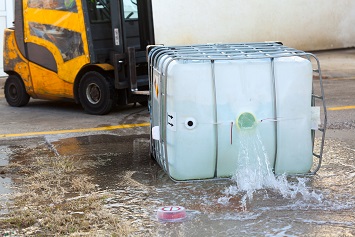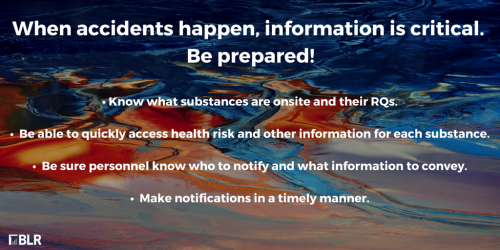A spill or release of a chemical just occurred at your facility. What do you do? Does it need to be reported? What information needs to be reported, to whom, and how soon?
These are the questions that need to be answered any time there is a spill or release at your facility. Section 304 of the Emergency Planning and Community Right-to-Know Act (EPCRA) establishes the federal requirements for emergency release notifications, which are implemented under 40 CFR 355.30 to 355.61.
What Is a Chemical Release and What Makes It Reportable?
A “release” is any spilling, leaking, pumping, pouring, emitting, emptying, discharging, injecting, escaping, leaching, dumping, or disposing into the environment of any hazardous chemical, extremely hazardous substance (EHS) listed under 40 CFR 355 Appendices A and B, or Comprehensive Environmental Response, Compensation, and Liability (CERCLA) hazardous substance listed under 40 CFR 302.4. Releases include abandoned or discarded barrels or containers.
If your facility accidentally releases a “reportable quantity” (RQ) of an EHS or CERCLA hazardous substance into the environment within a 24-hour period, you must comply with emergency release notification requirements.
However, emergency release notifications are not required if the release only results in on-site exposure or is a federally permitted release. In addition, there are other exemptions for specific substances or types of facilities.
When Must a Release Be Reported?
Two separate notifications must be made. The first, which is typically made by telephone, is an immediate notification upon becoming aware of the release. Then a written follow-up notification must be submitted as soon as practicable but typically within 30 days. In certain circumstances, multiple follow-up notifications may need to be made as additional information becomes available and to ensure all information submitted is accurate.
A stable, continuous release, one that is routine, anticipated, intermittent, and incidental to normal operations, requires an initial notification after establishing its basis as a continuous release. Follow-up notifications are only required if the reported normal range changes, the upper range is exceeded, or a new release occurs.
Who Receives the Notifications?
All release notifications must be submitted to the Local Emergency Planning Committee (LEPC) and State Emergency Response Commission (SERC) for any area that may be affected by the release. Reportable releases of CERCLA hazardous substances also require immediate notification to the National Response Center at 800-424-8802.
Individual LEPCs may have specific formats for making notifications, so it is a good idea to be in contact with your LEPCs before a release event occurs so you are aware of their expectations.
For releases occurring during transportation, the 911 operator should be contacted, and such releases do not require a written follow-up notification.
What Information Is Included in the Notifications?
The immediate notification should contain as much of the following information that is known at the time, but don’t delay the notification in order to retrieve all of this information:
- The chemical name and whether it is an EHS;
- An estimate of the quantity that was released;
- The time and duration of the release;
- The medium or media into which the release occurred;
- Any known or anticipated acute or chronic health risks associated with the release and, where appropriate, advice regarding medical attention necessary for exposed individuals;
- Proper precautions to take as a result of the release, unless such information is readily available to the LEPC in their emergency response plan; and
- The name and telephone number of the individual(s) to be contacted for further information.
The written follow-up notification should include, and update as needed, all of the information provided in the immediate notification, plus the actions taken to respond to and contain the release.
The notification content for a continuous release is detailed under 40 CFR 302.8(d) and 40 CFR 302.8(e).
Be Prepared!
No matter what facility or what precautions are taken, accidental releases can happen. So be prepared.
- Know what substances you have on-site and their RQs;
- Be able to quickly access information on health risks and other information associated with these substances; and
- Make sure that appropriate personnel know who to notify and what information they need to convey in the event of a release.
Be aware that even spills or releases of materials that you consider to be nonhazardous may be reportable under certain conditions or under state-specific release notification requirements.
If there are any questions about whether a spill or release is reportable, make the call. There are no penalties for unnecessarily reporting a release, but enforcement awaits if you fail to make proper notifications of a reportable spill.


